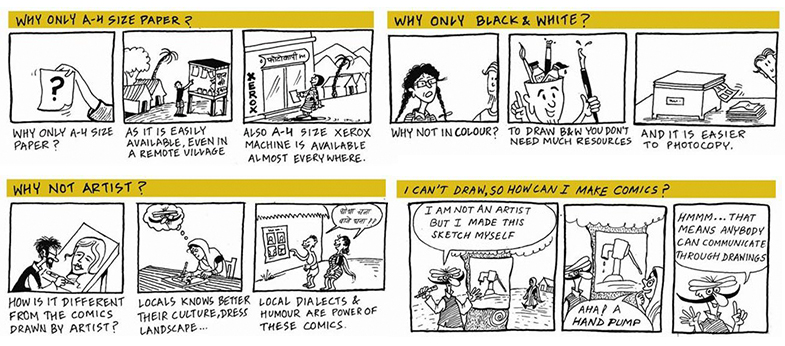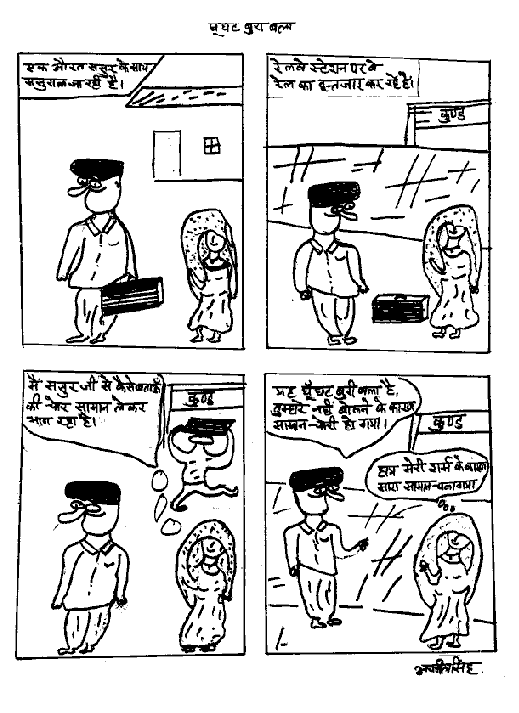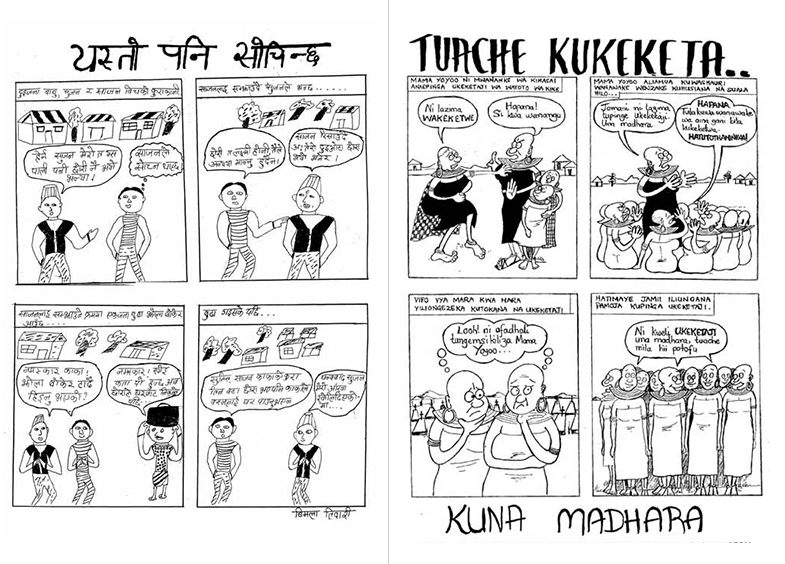World Comics Network – Introducing Grassroots Comics

The World Comics Network (India), started by political cartoonist Sharad Sharma in mid nineties, looks at introducing Grassroots Comics as a tool for communication and social design. Working with different communities, they emphasise on the value of visual art, self-expression and awareness in creating social change. Through their practice they have truly embraced the idea of design for the people and by the people, acting as a catalyst for change in the social sector.
Grassroots Comics as a medium stands out distinctly from mainstream comics since it is not created by professional artists. As the World Comics Network(WCN) puts it,
‘these comics are created by ‘You and Me’, common masses themselves. Comics have given a new direction to representation of silences thereby creating a revolution in itself. These comics are easy to-make, reproduced by simple photocopier and distributed in a limited demarcated area, which invites local debates among people from different socio-economic stratum of the society.’

WCN answers some of the most frequently asked questions in a comic format.
How Grassroots Comics operate
Primarily through the medium of a workshop which travels to several rural and remote areas in India and other countries, the workshop leaders gather community members to visualise topics of importance to them. With the help of a manual, which teaches them basics of expressions and postures, the participants then start storyboarding and visually representing their stories, in a simple four panelled A4 comic poster format. It is then inked in black, and photocopied to make several wall posters which are pasted at prime locations within the community like the village panchayats, shops, electric poles etc.
WCN has discovered the potential in the visual storytelling form of comics to connect with people of varying levels of literacy and in the process targeting a much larger audience. It is also this visual and easy to comprehend nature of comics which they have tapped into to build it as a medium to address issues that otherwise become sensitive topics and are not discussed out in the open.
Like in the case of the comic below which questions the veiling tradition in Rajasthan but in a simple, light hearted way, by basing the comic on a humorous yet practical problem.

“Veil System”, a lady is unable to inform her father-in-law about the theft of their luggage because of the veil system. Both regret the incident and the old tradition of veil system.
In case of these grassroots comics, the content is based on memories and stories of the community, represented in regional languages and aided by a strong sense of the visual culture and local perception of that space. Shifting focus from aesthetics, the idea behind the comics is to create something which is more contextual. Through the past fifteen years, these regional comics have covered a plethora of social issues as well as instances of development and accomplishments in these conflict ridden areas. With the use of minimum resources they capture underlying issues and people of a community and portray them in a thought provoking manner.
Designer as facilitator
While going through the project, what struck me the most was the change in the role of a designer in the field. From being the outsider who orchestrates such conversations, there is a now a need for the designer to assume the role of a facilitator to build a participatory and more inclusive process, which looks not just at locating challenges but also collectively – designer along with community – finding solutions for them. Besides bringing in our skills,the role we play in mobilising the thoughts and voices of the community becomes pivotal to the project. As Andrew Shea, in his book Designing for Social Change says, “sometimes you may need to fade into the background and observe, while at other times you might need to work side by side with the members of the community.”
Design for the community, with the community.
The challenge for an urban designer working in the rural context can be understanding who the target audience should be. The World Comics Network base their primary audience and context in the same space that they work in, thus pushing forward boundaries of designing with the community in order to design for the community.
It is only when these stories are distributed that they call for action. Exhibiting the photocopied comics of the participants in easily accessible areas of the community, builds a platform to not just showcase stories and talent, but also open up local debates and discussions within the community on topics which are otherwise neglected. The close proximity and the direct communication between the makers and the readers in the space provide a setup which initiates conversations and drives change.
In a Grassroots Comics Campaign, Apni Dikri Ro Haq ( Girl child right) initiated in Barmer District of Western Rajasthan,India in 2005, more than 300 wall poster comics were created by children and youth on topics of girl child rights, female foeticide, child marriage etc. A selection of which were circulated in several villages by the help of a motorbike rally, which paved way to serious debates and several local people committing themselves in bringing about change in the situation.

Left: Apni Dikri Ro Haq campaign, Barmer, Rajasthan.
Right: World Comics network in another village in Rajasthan, India.
Image Courtsey: World Comics Finland.
“During various discussions and brainstorming sessions, one thing emerged very clear – if we want this campaign to succeed, it has to first start ticking like a clock in peoples’ mind. We remembered what Mahatma Gandhi had said years ago; something which we thought was very much relevant to what we were planning. He had talked about a movement being launched by not working along the periphery of the society, but after penetrating deep into it. He had also reflected upon the fact that villages were the true image of real India.We decided to make these two observations of the Mahatma the pivot of our campaign” – Sharad Sharma
Give a man a fish and you feed him for a day. Teach him how to fish and you feed him for a lifetime
WCN has successfully created a system of sustained engagement, which doesn’t stop at one project, but gives its participants the required skill sets to continue such efforts within the community, without any outside help. The merit of the network also lies in the simple structure of the workshop, which not just makes well informed participants, but also empowers them to make change. While the focus is not on skills, the WCN has created many participants, who find their calling in the medium, and with time and under guidance of the WCN master the art, to build similar workshops within their own community. Like in the case of the Apni Dikri Ro Haq campaign in Barmer,the Barmer Comics Manch, a local initiative, now continues the campaign.
A basic manual , introducing grassroots comics, is also available on free to download basis on the website in English and Hindi. Other languages for the manual can also be requested.
The easy to understand and cost effective nature of the workshop has found popularity in the development sector, which has led to the same method now being followed by several NGO’s and other individuals in countries like Pakistan,Nepal, Sri Lanka, Brazil, UK and Tanzania to name a few. The Indian network has also collaborated with World Comics Finland to introduce grassroots comics in many areas, along with setting up a separate network for Pakistan as well as Nepal.

Left: Comic from Nepal – On girl child and the importance of a daughter.
Right: Comic from Africa - On Female Genital Mutilation.
You can also look at these comics on their website, as well as purchase some compiled publications.

